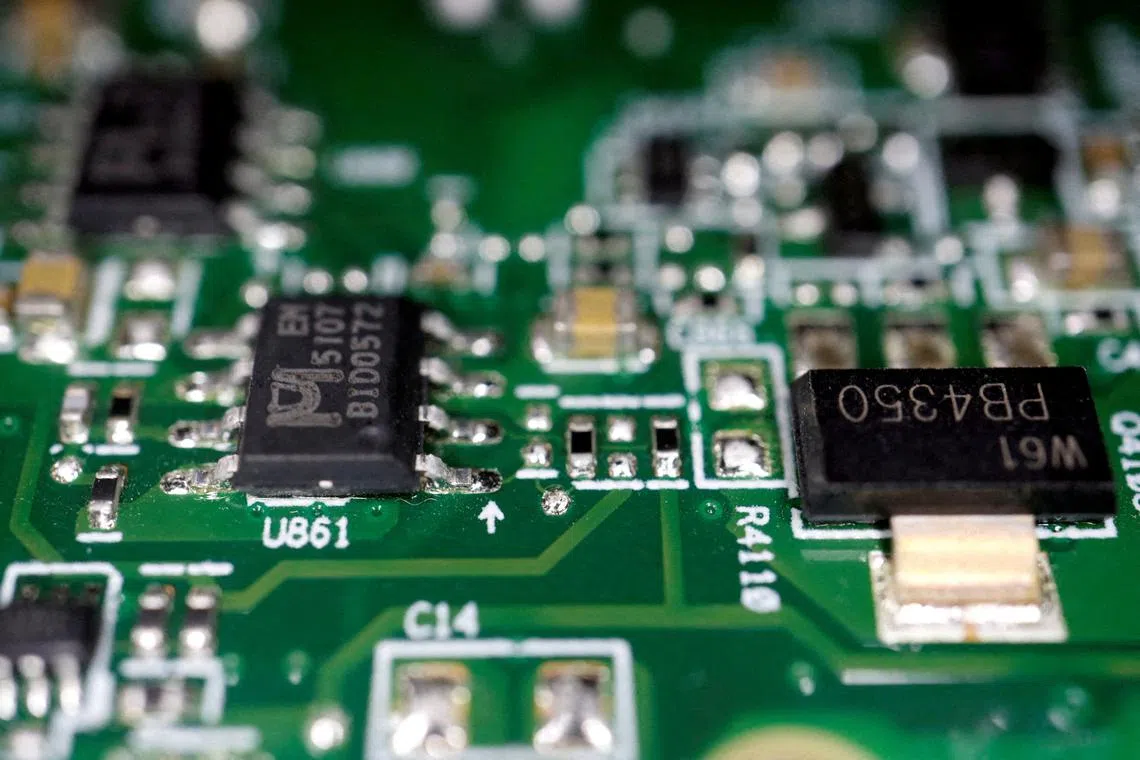China invests $65.4 billion in its biggest-ever chip fund to back nation’s firms
Sign up now: Get ST's newsletters delivered to your inbox

The latest investment vehicle, known as Big Fund III, underscores a renewed push from President Xi Jinping’s government to build its own semiconductor industry as tensions with the US escalate.
PHOTO: REUTERS
Follow topic:
SINGAPORE – China has set up the country’s largest-ever semiconductor investment fund to propel development of the domestic chip industry, the latest effort from Beijing to achieve self-sufficiency as the US seeks to restrict its growth.
The third phase of the National Integrated Circuit Industry Investment Fund, also known as the “Big Fund”, has amassed 344 billion yuan (S$65.4 billion) from the central government and various state-owned banks and enterprises, including the Industrial and Commercial Bank of China, according to Tianyancha, an online platform that aggregates official company registration information. The fund was incorporated on May 24.
The latest investment vehicle, known as Big Fund III, underscores a renewed push from President Xi Jinping’s government to build its own semiconductor industry as tensions with the US escalate.
The Biden administration has imposed sweeping restrictions on China’s ability to buy advanced chips and chipmaking equipment. It is now also urging allies – including the Netherlands, Germany, South Korea and Japan – to further tighten curbs on China and plug holes in existing export controls.
Shares of China’s major chip stocks jumped on May 27. Semiconductor Manufacturing International Corporation (SMIC), the largest chipmaker in China, rose as much as 8.1 per cent in Hong Kong, while Hua Hong Semiconductor, a smaller competitor, climbed more than 10 per cent.
The largest shareholder in the latest fund is China’s Ministry of Finance, while investment firms owned by local governments in Shenzhen and Beijing also contributed. The Shenzhen government has been supporting several chipmaking plants in south China’s Guangdong province in a bid to free Huawei Technologies from years of US sanctions that cut it off from a great number of imported semiconductor components.
Superpowers led by the US and European Union have funnelled nearly US$81 billion (S$109.3 billion) towards cranking out the next generation of semiconductors, escalating a global showdown with China for chip supremacy. The Biden administration’s 2022 Chips and Science Act includes US$39 billion in grants for chipmakers, as well as US$75 billion in loans and guarantees.
The national chip fund was inaugurated about a decade ago with roughly 100 billion yuan in investable capital. Mr Xi, soon after becoming the Chinese president, started a massive overhaul of the country’s manufacturing industry, aiming for sophisticated technologies from robotics to advanced chipmaking.
China more than doubled the size of Big Fund II in 2019 as the race against the US for tech supremacy intensified during the Trump administration. The capital was used to fund some of the country’s most promising chip projects, such as SMIC’s new factories.
But Beijing’s generous investments have not always paid off. China’s top leadership was frustrated with a years-long failure to develop semiconductors that could replace US circuitry. In addition, the former boss of the Big Fund was removed and investigated for corruption.
The Biden administration has taken unprecedented steps to slow China’s technological progress, arguing that such measures are necessary for US national security.
Over the last two years, the US has cut off China’s ability to buy the most advanced chips from Nvidia, which are used to train artificial intelligence models, as well as the most sophisticated chipmaking machines from the likes of ASML Holding and Applied Materials.
China has responded by ratcheting up its investments in less-advanced chipmaking capabilities. It is now building a network of chip companies around its national champion Huawei for technological breakthroughs in advanced chip development and manufacturing.
The newly created Big Fund III may provide funding for those projects. REUTERS

